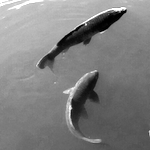Metachronal swimming in shrimp is characterized by the sequential beating of five closely spaced flexible pairs of swimming legs (pleopods), phase-shifted in time. A distinct feature of the pleopods is their differential stiffness: they are rigid during the power stroke but bend almost horizontally during the recovery stroke. The stiffness and increased surface area of the pleopods during the power stroke have been shown to maximize thrust. However, the effect of bending on the near-body flow and the associated forces during the recovery stroke has received far less attention despite being crucially significant in reducing drag. The underlying mechanism enabling differential stiffness is also unreported. By combining μ-CT scans and stiffness measurements on shrimp pleopods, we find that the concave geometry of the legs makes them twice as flexible during the recovery versus the power stroke. Kinematics and particle image velocimetry data (obtained in parallel) show that bending enables inter-pleopod physical interactions causing up to three legs to coalesce at any time during the recovery stroke. Unlike the power stroke, these complementary mechanisms result in no observable wake shed by the pleopods. We use these results to develop a bio-inspired scaled robot including five morphologically accurate pleopod analogs mounted in series and integrating differential stiffness. We compare the thrust and drag forces against rigid pleopods to test the hypothesis that bending and coalescence effectively reduce the drag of three legs to that of only one. Considering appendage stiffness leverages our understanding of metachronal propulsion for designing novel underwater robots.

 PDF version
PDF version
